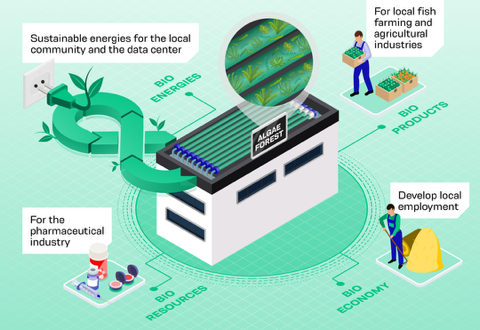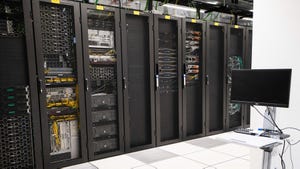Could Algae Be the Key to Data Center Sustainability?Could Algae Be the Key to Data Center Sustainability?
A new bio-circular energy initiative aims to explore innovative avenues in data center sustainability.

In a bold move towards data center sustainability and energy efficiency, a French data center operator has partnered with academics to pioneer a novel approach: utilizing surplus heat to grow algae.
A pilot project from Data4Group, in collaboration with the Université of Paris-Saclay, aims to cultivate biomass by harnessing surplus heat and captured carbon dioxide (CO2) emissions, potentially opening up new possibilities for circular energy in data centers.
Data4’s research project is in response to the “strategic challenge” of reusing heat and CO2 emissions produced by data centers. The initiative comes at a crucial time, with both the International Energy Agency (IEA) and the United Nations urging data centers to reduce CO2 emissions to combat climate change. Despite years of focus on sustainability, data centers still struggle to curb heat output.
According to think-tank Energy Innovation, large data centers individually produce over 100 MW of energy, with entire campuses reaching up to 300 MW – enough to power mid-sized cities.Data centers and data transmission networks accounting for 0.6% of total energy-related greenhouse gas (GHG) emission according to the IEA.
Researching the ‘World’s First Bio-Circular Data Center’
According to the operator, although the industry has already been exploring energy reuse technologies, such as heating nearby homes, these solutions are only able to capture 20% of the heat produced.
This latest initiative aims to increase the amount of captured data center heat and use captured CO2 to “reproduce a natural photosynthesis mechanism” and grow algae. The algae will then be recycled as biomass to develop new sources of circular energy and be used in the manufacture of bioproducts for other industries, including cosmetics and agri-food.

The project is exploring how waste data center heat can be used to create new circular energy resources (Image courtesy of Data4)
Patrick Duvaut, president of the Université Paris-Saclay Foundation, underscores the simplicity of the concept, drawing parallels to natural processes where algae growth, fueled by heat and CO2 absorption, played a pivotal role in shaping the Earth’s atmosphere.
“For three billion years, the planet’s atmosphere had had 10,000 times more CO2 than today,” Duvaut told Data Center Knowledge. “Algae burned CO2 and used heat from the sun to grow, which then generated plankton and fish. Today, human beings can breathe because of this phenomenon.”
Harnessing Surplus Heat: A Path to Data Center Sustainability?
Data center companies worldwide are investing in sustainable technologies with a focus on heat reuse potential.
For instance, Facebook’s facility in Odense, Denmark, recycles warm air from the data center to heat nearby homes, while Quarnot Computing, a start-up in France, distributes data center heat through digital heaters, offering free heat to customers. Elsewhere, atNorth’s SWE01 site in Sweden is equipped with a recovery system for both air-cooled and liquid-cooled IT infrastructures. All the residual heat from the data center is recycled in collaboration with the local district heating provider. This initiative, at full capacity, will be able to heat tens of thousands of apartments in the area.
Like atNorth, many data centers in Sweden have committed to carbon reduction enterprises like the Climate Neutral Data Center Pact. Fredrik Jansson, spokesperson for atNorth, says they are in active pursuit of heat reuse methods whether within greenhouse environments or for fish farming.
“The ability to recycle waste heat from data center cooling processes also enables clients to decarbonize their digital infrastructure,” Jansson told Data Center Knowledge.
However, the challenge of finding alternative uses for data centers’ waste heat is evident in a 2022 Uptime Institute report. Given that designing a data center for heat reuse is typically feasible in colder regions, especially where heating constitutes 50% of energy demand and 70% of that relies on fossil fuels, it's crucial to explore alternatives, especially with the expanding role of artificial intelligence.
At this year’s Data Center World conference in Washington, DC, experts from the US Department of Energy and academia highlighted the importance of harnessing waste heat, urging the industry to develop innovative solutions.
“Facilities can reduce the cost burden and their carbon footprint by finding ways to harness waste heat,” said Kyle Mangini, who looks after all laboratory and mechanical systems at the Amherst College Science Center, at Data Center World.
Reimagining Waste Heat Management
The Data4 group has been tackling the issue of wasted data center heat for several years. The new R&D project with the Université Paris-Saclay allows them to pool resources while developing an industrial ecological project to reduce consumption, they say.
“This augmented biomass project meets two of the major challenges of our time: food security and the energy transition,” said Linda Lescuyer, Data4 innovation manager.
The core concept being demonstrated, Lescuyer says, is the use of a unified technology to extract heat from data centers and channel it into algae cultivation. This technology encompasses the collection of algae, allowing flexibility in selecting the type of algae to produce based on specific business models.
“You don’t need heat in warm countries,” says Lescuyer, “but you could imagine that data centers could provide heat and these algae could be used for fish production, or even for creating some vegetable you are able to eat. One could duplicate this country by country, even campus by campus according to the benefits you want to provide.”
For instance, in regions like France where fish production isn’t local, algae can be used as agri-food for fish, thereby reducing transportation needs and lowering the carbon footprint of food.
This approach can create new local businesses, jobs, and food sources, according to Lescuyer. Conversely, in areas with abundant energy resources but lacking fish production, algae can be utilized for energy production, fostering the conditions needed for a bio-circular energy system. For instance, in regions like Spain, where the pharmaceutical industry relies on algae for medicine, local algae production can reduce CO2 emissions associated with transportation and potentially lower costs due to local production and involvement of community members.
Dominika Koncewicz, an industry analyst at Omdia, said alternative heat reuse is of “growing importance of sustainability practices within data centers, particularly with the increasing demand for power and resources driven by AI.”
“Utilizing heat reuse to grow algae represents a great example and promising innovation in curbing CO2 emissions,” Konecewicz told Data Center Knowledge, adding that it aligned with sustainability goals major data center players are chasing.
“However, its scalability and success hinge on effective implementation and integration into data center operations,” said Koncewicz.
Capturing the Market
“Technologically, there is little risk in terms of feasibility and workability,” said Université Paris-Saclay's Duvaut. “It’s only a question of engineering. This is where it’s very virtuous and then we add another step of circularity because we can convert algae into biomass or into biomolecules or into biohydrogen. This is a first. Nobody has done that before.”
Over the past decade, the European Union has been urging member states to adopt district heating schemes, offering financial support to startups. The rationale behind this push is the belief that district heating is both more efficient and less carbon-intensive compared to traditional electric or gas central heating systems.
By leveraging excess heat and capturing CO2 to grow algae, Duvaut says, the project would establish a circular energy system. Or, as demonstrated by a feasibility study conducted in collaboration with the startup Blue Planet Ecosystems, algae grown can achieve a carbon capture efficiency up to 20 times greater than that of a tree, when considering an equivalent surface area.
About the Author
You May Also Like









